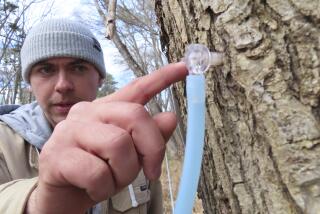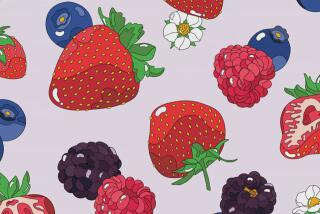We’ve got you covered
There is nothing in all the pastry chef’s art that can compare to a perfect peach -- the melting texture, the heady perfume, the complex interplay of sweet and tart. But just how many times in a summer do you find perfection?
Face it; most of the fruit we buy can use a little help. That’s why desserts were invented in the first place. The assist can come in the form of something as tricky as puff pastry or in a syrup so basic its official name is simple.
And while there are few things easier to make than a simple syrup -- just boil sugar and liquid until clear -- so are there few things that allow as much room for experimentation, or reward it as generously.
One of my favorite summer desserts uses a simple syrup scented with mint and lime peel as a sauce for thinly sliced melons. Just five ingredients, but you cannot believe the complexity of the flavor.
That’s just one example. Playing with an assortment of flavoring ingredients found in my garden and pantry last week, I came up with some really interesting syrups perfect for giving summer fruit a discreet boost while you’re waiting to find that perfect peach.
My first surprise was how these syrups reveal the details of flavors, even before you add the fruit.
Steeped in sugar syrup, vibrant rose geranium leaves turn delicately floral, almost ethereal. Jasmine pearl tea, on the other hand, is exuberant with a slightly bitter tea undertone. Chamomile is all grass and musky flowers. Black peppercorns are shocking; the syrup plays up their floral aspect and reveals an almost tropical fruit dimension I might never have suspected.
Some ingredients I thought would be similar proved to be different when steeped in the syrup-- and in interesting ways.
The lemon in verbena becomes almost creamy and smooth, while that in my very citrusy-smelling Mabel Grey geranium is spiky and tart. At the same time, I never would have expected to find verbena’s same lemon cream flavor in fresh basil, but there it was, with a defining minty overtone all its own.
With this variety of flavors in the syrups, you would expect there to be differences in how well each matches with different kinds of fruit. And so there was. I’d picked up an assortment of thoroughly run-of-the-mill specimens at the supermarket -- apricots, cherries, strawberries, blackberries, peaches, nectarines and figs. While none of them were really awful (well, the peaches came close, but it’s still very early for them), none were of the quality to make a farmer -- or a shopper -- shine with pride. I really wanted to see what these syrups could do.
Matching flavors is a tricky business; witness the reliability (or lack thereof) of all that wine-and-food advice. While it’s difficult to predict specifics, in general, it’s safe to say there are some things that just don’t work, things that clash like plaid on plaid. Then there are flavors that peaceably co-exist like distant neighbors.
And then every once in a great while there are the happy occasions when one taste meets another and the result is like the ringing of a bell -- the peaks of one match the valleys of the other, and together they taste much better than they ever could separately.
Most of my experiments ended up in the middle range. And, there were a few things that just flat didn’t work. I don’t think I’ll ever again pair figs with a rose geranium syrup. Theoretically it seems a natural, but in practice the syrup emphasizes the slightly bitter woodiness of the figs’ skin. And I don’t think the lemon verbena syrup works with apricots either. Somehow they tasted even more coarse and flat.
The flavoring with the highest number of hits was the jasmine pearl tea. A fairly hard-to-find variety, it is now available at some high-end groceries (imported by Imperial Republic, a cooperative venture between the Republic of Tea and San Francisco’s Imperial Tea Court). It is crazily expensive -- almost $30 for three ounces -- but it proved to be worth the cost. Just one teaspoon was enough to perfume a cup of syrup, and it was heavenly paired with cherries, figs and blackberries.
Just as successful -- and far more down-to-earth in price -- were black peppercorns. Oddly, though they are at opposite ends of the flavor spectrum, the jasmine tea and black peppercorns matched best with the same fruits.
Basil was another pleasant surprise. Though we tend to think of it only in a savory context, it was terrific with cherries, strawberries and figs. The chamomile tea syrup was great with cherries, revealing a dark floral character. It also worked really well with blackberries and was OK with figs.
While the lemon verbena syrup was not good with the apricots, it was a pleasant companion -- though rarely more than that -- to most of the other fruits. The exception was figs, with which it really shone.
The citrusy Mabel Grey geranium was even more particular -- it was very good with the figs, only co-existed with the cherries and didn’t play well with anything else. I liked the rose geranium a lot with peaches and nectarines, and it was good with cherries and blackberries.
To begin my experiments, I first tried making syrups with concentrations of a third, a half, and two-thirds cup of sugar to a cup of water to find out which worked best.
The two-thirds was simply too sweet. But less sweet was not necessarily better: The syrup made with one-third cup of sugar didn’t seem to amplify the flavorings very well. The syrup made with half a cup of sugar did that best and also was slightly thicker, so it coated the fruit a little better.
Once you’ve made the first syrup, there is a whole world of options to explore. If a flavoring is good by itself, what about pairing it with another? When I was done with my experiments, I tried combining my two favorite syrups -- the jasmine and the black peppercorn -- just to see what would happen. The result was even more delicious.
Furthermore, my syrups were all made with water, but other liquids would work at least as well. The obvious next jumping-off point would be wine, which offers a whole different set of possibilities -- and complications.
Let’s see, would a Zinfandel work best with black peppercorns? Rose geranium? Jasmine? And then which fruit would I serve it with? And what about sweetening with honey instead of sugar?
For once, I’m glad mediocre fruit is so plentiful.
*
Russ Parsons can be reached at russ.parsons@latimes.com
*
Nectarines and blackberries in rose geranium syrup
Total time: 20 minutes
Servings: 6
Note: This is a master recipe. It’s fun to experiment with different combinations of herbs or spices and fruits. See our list of flavorful variations or try some of your own.
1 cup water
1/2cup sugar
2 tablespoons chopped rose
geranium leaves
4 nectarines (about 2 1/2 cups) pitted and sliced into 3/4-inch wedges
1 cup blackberries
1. In a small saucepan, whisk the water and sugar over high heat until the sugar is in suspension and no longer mounded on the bottom of the pan. Bring the mixture to a boil and cook until all of the sugar is dissolved, about 5 minutes. If this happens before the water boils, heat to the boil anyway.
2. When the water comes to a boil, remove the pan from the heat and add the rose geranium leaves. Let the mixture steep at least 10 minutes while you’re slicing the nectarines.
3. Combine the nectarines and blackberries in a large bowl or divide evenly among 6 small ones. Ladle the warm syrup through a strainer over the fruit. This can be done up to 2 hours in advance and held at room temperature until serving.
Each serving: 121 calories; 0 mg. sodium; 0 mg. cholesterol; 0 grams fat; 0 grams saturated fat; 30 grams carbohydrates; 1 gram protein; 3 grams fiber.
*
Pick and pair
Here are some pairings of flavored syrups and the fruits they best enliven. Follow the directions in the recipe for nectarines and blackberries with rose geranium syrup, substituting herbs and fruits as follows.
*--* Herb/Spice Amount Fruit Basil 2 tblsps. chopped fresh leaves Cherries, strawberries, figs Black peppercorns 1 tsp. crushed -- not ground -- black Cherries, figs, blackberries peppercorns Chamomile 1/2 tsp. powdered chamomile tea, made Cherries, blackberries with all flowers only Jasmine 1 tsp. jasmine pearl tea Cherries, figs, blackberries Lemon verbena 2 tblsps. chopped fresh leaves Figs Mabel Grey geranium 2 tblsps. chopped fresh leaves Figs Rose geranium 2 tblsps. chopped fresh leaves Nectarines, peaches
*--*
More to Read
Eat your way across L.A.
Get our weekly Tasting Notes newsletter for reviews, news and more.
You may occasionally receive promotional content from the Los Angeles Times.










